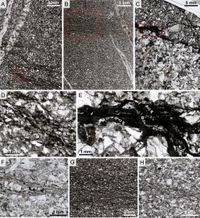A recent study reveals groundbreaking insights into the preservation of ancient microbial life, specifically through the exploration of microbial mats dated to approximately 2.9 billion years ago found in the Mosquito Creek Formation in Pilbara, Australia. Researchers have discovered that the presence of aluminous phyllosilicates plays a crucial role in maintaining the complex biogeochemical signatures of these early life forms, paving the way for potential discoveries of biosignatures on Mars.
The study, published on March 19, 2025, involved advanced microscopy and geochemistry to analyze microbial mats preserved within fine to coarse-grained sandstones. Notably, while the organic layers typically measured between 0.1 to 0.5 mm thick, some instances exceeded 1 mm. The exceptional retention of organic materials defies expectations for coarse siliciclastic rock formations, where the energetic environments often hinder the preservation of delicate biological remnants.
Lead researcher K.H. Lewis, along with collaborators at the Oxford University Museum of Natural History and the Korea Basic Science Institute, utilized various advanced microscopy techniques to gain insight into the micro-nano-scale characteristics of these microbial mats. The study emphasizes that their preservation mechanism is largely attributed to the interaction between organic materials and phyllosilicates at the nanoscale, which shields microbial remnants from degradation over geological timescales.
Through their investigation, the authors found that the thermal maturity of organic materials within the microbial layers ranged between 313 and 363°C, demonstrating that those rich in phyllosilicates exhibited lower peak temperatures compared to matrix materials. This indicates that the presence of phyllosilicates contributes to a more stable environment, allowing for the preservation of intricate biogeochemical complexities.
As the authors elucidate, "Exceptional preservation of organic materials is typically atypical for coarse-grained siliciclastic sedimentary rocks." Their findings reveal a novel preservation pathway driven by lithological mechanics within the sediment. Aluminous phyllosilicates reduce porosity and permeability, creating anoxic conditions that protect organic material from oxidative decay, vital for any potential biosignature research.
The implications of these findings extend far beyond Earth, reigniting interest in searching for ancient life on Mars. The delineation of suitable environments for preserving biosignatures is crucial. The Mars 2020 Perseverance rover has already collected samples from phyllosilicate-rich sandstones, marking critical steps toward understanding the planet's historical biosphere.
"Understanding modes of preservation in coarse-grained siliciclastic environments is highly relevant for the search for life on Mars," the authors wrote, underlining the potential parallels between organic preservation on our planet and Mars. As additional research continues, the new findings present an opportunity to scrutinize previously overlooked geological formations for evidence of ancient life.
While microbial mats and their intricate structures provide critical insight into early biospheric evolution, further investigations may uncover additional dimensions of biogeochemical complexity in similar ancient rocks, potentially shedding light on the origins of life as we know it.
Overall, this research encourages a comprehensive examination of ancient siliciclastic formations, with the aim of understanding microbial processes that contributed to the development of complex ecosystems. With careful analysis and advanced techniques, scientists hold the keys to unlocking some of the critical riddles of our early planet and potentially our neighboring worlds.

